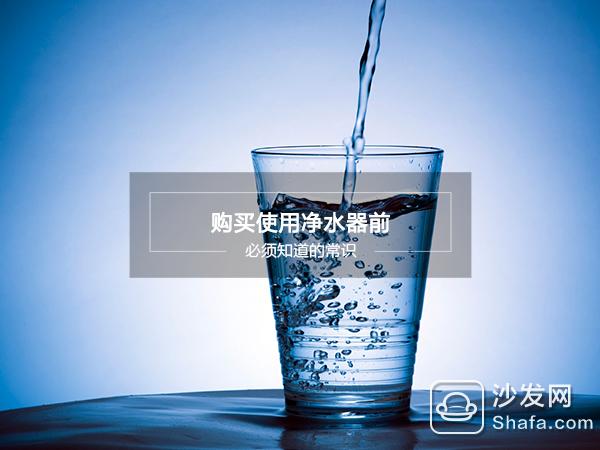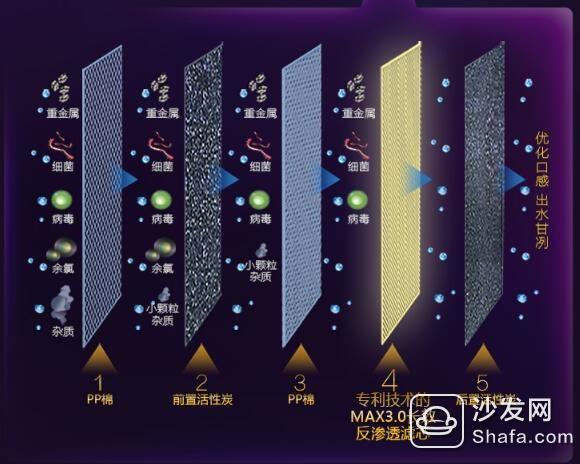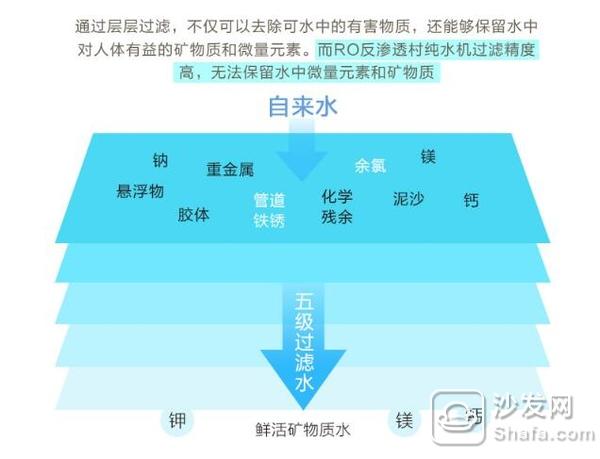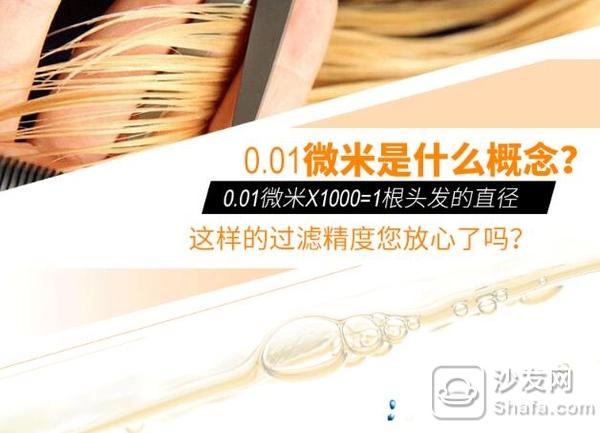[PConline Talk] In recent years, with the improvement of living standards and some public events on water pollution have been exposed, we are increasingly concerned about drinking water safety issues. According to statistics from the National Environment Department, 82% of rivers in China are polluted to varying degrees, and 50% of urban groundwater is polluted. Although many urban residents nowadays have the habit of drinking bottled purified water, they may experience secondary pollution due to the need to go through many intermediate links from the factory to drinking. Therefore, many people will consider buying household water purifiers. However, water purifiers are not as common as traditional home appliances, and their use effects are difficult to detect with the naked eye. Therefore, for consumers, how to purchase has always been a problem.

Articles on water purifiers on the Internet are often “entrained†with some branding information, and it is difficult to evaluate their accuracy. The following science article, theory and data are collected from published papers or academic research results. No specific products will be mentioned. We hope to provide some references for everyone to purchase water purifier products.
Classification of water purifiers
Home water purifiers first appeared in China in the 1980s. Their role was to filter urban tap water, remove large particles of impurities, heavy metals, bacteria and other harmful substances. At present, there are common kitchen-type water purifiers, faucet-type water purifiers, and portable desktop kettles. The first two objects of purification are urban tap water, and the net kettle is generally used to purify drinking water in the office.

There are clear differences between the use of clean water products abroad and domestic ones. For example, in Europe, the use of net water bottles is more, and desktop small water purifiers are also more common, because the tap water quality in these countries has reached the standard for raw drinks, so the use of water purification products is mainly to improve the taste. In China, tap water is not suitable for drinking, so it is not advisable to use a pure water bottle to purify tap water. In the purification effect, the kitchen-type (including hanging on the wall) is generally better than the tap-type, so in theory, the kitchen-type water purifier is more suitable for daily use of the family.
The principle of water purifier
There are mainly four methods for water quality treatment. One is activated carbon-based medium filtration (such as activated carbon/PP cotton filter), and the other is microfiltration, ultrafiltration, nanofiltration, and reverse osmosis membrane separation. Is based on the sterilization of physical and chemical disinfection methods (such as ultraviolet disinfection), the fourth is softening, electrolysis-based water quality regulation. The specific method to use depends on the conditions of use. Such as the net kettle, because of the small size, inconvenient to use ultraviolet, electrolytic and other methods, but also can not produce enough pressure for membrane separation filtration, so the use of media filtration method.
The following figure shows an example. Currently, the kitchen-type water purifier generally combines the media filtration method and the membrane separation method to form a filter cartridge. So to evaluate the quality of a water purifier, mainly to see the filter is good or bad. The price difference between the water purifiers also comes mainly from the filter element. The more the filter material is used, the greater the number of filter layers and the better the purification effect.

In most cases, tap water enters the water purifier and passes through the media filter module in the filter cartridge. At this stage, most of the suspended solids, deodorants, and larger molecules of organic matter in the water are adsorbed by activated carbon and other media. However, studies have shown that activated carbon has a very obvious removal effect only on organic matter with a molecular weight of 500-3000, but it has little effect outside this range. Therefore, there may be residues of bacteria, viruses, and heavy metals in the water at this stage. This time it was the turn of membrane separation.
We all know that a balloon that is full of gas will gradually become smaller even if it does not leak. This is because there is a gap between the molecules, and the elasticity of the balloon will already exert a certain pressure on the internal air and accelerate the internal air. The escape. Membrane separation method can also be understood that the membrane pores used for the purification of water are very small. Under the effect of pressure, solvent (water) and quantitative solute (water impurities) can pass through the membrane, and the remaining substances are trapped on the other side. .
Water purifier main indicators
The key is coming! What is the concept of reverse osmosis, microfiltration, and ultrafiltration seen when buying a water purifier? In fact, this is the name given to the four different membrane pore size membranes used in the membrane separation process. The complete classification is: microfiltration membrane (MF), ultrafiltration membrane (UF), nanofiltration membrane (NF) and reverse osmosis membrane (RO). The smaller the membrane aperture, the higher the filtration accuracy, the greater the working pressure, and the slower the passing speed.
Microfiltration membrane pore size 0.05-5.00μm, operating pressure 0.01-0.2Mpa, can retain 0.02-10μm examples; ultrafiltration membrane pore size 5nm-0.1μm, operating pressure 0.1-1.0Mpa; nanofiltration between ultrafiltration Between the reverse osmosis, a higher water throughput can be achieved at a pressure of 0.5-1.0 MPa; while the reverse osmosis membrane has a pore diameter of only 1-10 angstroms (one-tenth of nanometer), and almost the water can be removed. All impurities, including various suspended solids, colloids, dissolved organics, inorganic salts, bacteria, and microorganisms, theoretically the water quality is infinitely close to pure water.
We went to the e-commerce site to search and found that the top-ranked products were mainly reverse osmosis water purifiers and ultrafiltration water purifiers. Because of the high cost of reverse osmosis membranes, prices of reverse osmosis water purifiers were generally too expensive. Are more than 1,000 yuan. Just now we also mentioned that the purification accuracy of reverse osmosis water purifiers is higher, but the following diagram shows this ultrafiltration water purifier in the introduction of products. Their products use ultrafiltration membranes, which can retain minerals beneficial to the human body in water. And trace elements, while the RO reverse osmosis water purifier has high filtration accuracy and can not retain trace elements and minerals in water. Is this really the case?

In fact, this sentence is very ambiguous, read the film classification just now, we know that the difference between ultrafiltration membrane and reverse osmosis membrane is mainly poor in membrane pore size. Reverse osmosis membranes cannot really retain trace elements and minerals in water, but because minerals and trace elements are good or bad, the quality of these substances will not be distinguished by their size, so ultrafiltration membranes cannot be judged. Which minerals and trace elements are beneficial to the human body. The logic of this sentence is that there are minerals and trace elements that are beneficial to the human body in the water → the reverse osmosis membrane cannot retain these substances, and the ultrafiltration membrane can retain these substances → the ultrafiltration water purifier is better. But the main premise of this logic ignores another aspect - the water also has harmful minerals and trace elements. So ultrafiltration is better than reverse osmosis. It is certainly not true that they are not explicitly stated in the publicity. However, there is no doubt in logic that leads consumers to think in this direction.
Ultrafiltration membrane can effectively shield suspended particles, colloids, turbidity and bacteria, but the removal efficiency of organic matter in water is not high. Therefore, the fact is that both ultrafiltration and reverse osmosis have their own advantages and disadvantages. Which one to buy depends on the specific needs and prices.
Speaking of minerals and trace elements, there are some mineral water purification products on the market that are supplemented with minerals that have been filtered out. That is, on the basis of decontamination, adding some of the beneficial mineral elements to the human body through the addition of wheat slate, but its effect is still controversial in the academic community, not necessarily really useful.
Look at the water purifier of this faucet and use an analogy method to compare its purification accuracy to the one-thousandth of the diameter of the hair wire, and ask: “Do you feel at ease with this kind of filtration accuracy?†In fact, this accuracy is the ultrafiltration membrane. The accuracy of the ultrafiltration membrane is difficult to remove because of organic matter it is difficult to remove. According to this statement, the reverse osmosis membrane filter accuracy is one hundred times higher than this water purifier! Conversely speaking, the purification accuracy of this water purifier is only one percent of the reverse osmosis water purifier. Do you still have confidence in the filtration accuracy? The facts are the same, but in other words, the effect is diametrically opposite. Therefore, when purchasing a water purifier, when you encounter a lot of rhetorical or figurative sentences, you must think more.

In addition to the filter element, filter membrane, and filtration accuracy, we will also see parameters such as “clean water flow†and “rated total net water volumeâ€. The meaning of “rated total net water volume†means that without changing the filter element , The maximum amount of water that can be purified from when the consumer starts to use the filter to when it needs to be replaced. However, due to the different water quality in different regions, this figure has only reference significance; the greater the flow of clean water, the faster the water discharge rate.
Of course, apart from what we just said, there are many other factors that will also be included in the scope of our purchase of water purifiers. However, knowing some common sense, at least when we face advertising, we can make more favorable judgments for ourselves. .
KNM3 Series Moulded Case Circuit Breaker
KNM3 series Moulded Case Circuit Breaker is MCCB , How to select good Molded Case Circuit Breaker suppliers? Korlen electric is your first choice. All moulded Case Circuit Breakers pass the CE.CB.SEMKO.SIRIM etc. Certificates.
Moulded Case Circuit Breaker /MCCB can be used to distribute electric power and protect power equipment against overload and short-current, and can change the circuit and start motor infrequently. The application of Moulded Case Circuit Breaker /MCCB is industrial.
Korlen electric also provide Miniature Circuit Breaker /MCB. Residual Current Circuit Breaker /RCCB. RCBO. Led light and so on .
KNM3 series Molded Case Circuit Breaker,Small Size Molded Case Circuit Breaker,Electrical Molded Case Circuit Breaker,Automatic Molded Case Circuit Breaker
Wenzhou Korlen Electric Appliances Co., Ltd. , https://www.zjmannualmotorstarter.com